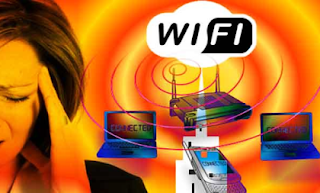Can you really get sick with Wi-Fi? What is the effect of wireless signal on the body?
According to the parents of a 12-year-old boy in Massachusetts the strength of the school's Wi-Fi signal is making their son sick. And they are suing the school, the private Fay School in Southborough, for it.
The boy, who, along with his parents, remains anonymous in the lawsuit, has been diagnosed with electromagnetic hypersensitivity syndrome (EHS). That’s when electromagnetic radiation — emitted from wireless technology including Wi-Fi, cellphones, and cell towers — is the apparent cause of nosebleeds, nausea, headaches, dizziness, memory loss, tremors, exhaustion, and heart and thyroid problems.
While EHS is not universally recognized among medical professionals, the World Health Organization (WHO) has acknowledged it since 2005. And the boy’s family and environmental health physician, Jeanne Hubbuch, says she has found no other explanation for the boy’s symptoms.
“It is known that exposure to Wi-Fi can have cellular effects. The complete extent of these effects on people is still unknown,” Hubbuch wrote in a letter to the school, according to the Telegram & Gazette.
“But it is clear that children and pregnant women are at the highest risk. This is due to the brain tissue being more absorbent, their skulls are thinner and their relative size is small.”
The boy’s diagnosis came after the school installed a new, more powerful wireless system in 2013, according to the Telegram & Gazette.
But the school maintains that its radiation output falls well within safe levels. A statement provided to Yahoo Parenting by the administration notes that when the parents first raised their concern in 2014, “Fay School addressed the parents’ concern as it would any parental concern.” It hired radio-signal measurement company Isotrope, experts recommended by the boy’s parents.
The lawsuit reportedly asks for a U.S. District Court injunction that would require the Fay School to either switch to Ethernet cable, lower the Wi-Fi signal in the boy’s classroom, or make another suitable accommodation — or else the boy will have to leave the school. It also seeks US$ 250,000 in damages.
According to the parents of a 12-year-old boy in Massachusetts the strength of the school's Wi-Fi signal is making their son sick. And they are suing the school, the private Fay School in Southborough, for it.
The boy, who, along with his parents, remains anonymous in the lawsuit, has been diagnosed with electromagnetic hypersensitivity syndrome (EHS). That’s when electromagnetic radiation — emitted from wireless technology including Wi-Fi, cellphones, and cell towers — is the apparent cause of nosebleeds, nausea, headaches, dizziness, memory loss, tremors, exhaustion, and heart and thyroid problems.
While EHS is not universally recognized among medical professionals, the World Health Organization (WHO) has acknowledged it since 2005. And the boy’s family and environmental health physician, Jeanne Hubbuch, says she has found no other explanation for the boy’s symptoms.
“It is known that exposure to Wi-Fi can have cellular effects. The complete extent of these effects on people is still unknown,” Hubbuch wrote in a letter to the school, according to the Telegram & Gazette.
“But it is clear that children and pregnant women are at the highest risk. This is due to the brain tissue being more absorbent, their skulls are thinner and their relative size is small.”
The boy’s diagnosis came after the school installed a new, more powerful wireless system in 2013, according to the Telegram & Gazette.
But the school maintains that its radiation output falls well within safe levels. A statement provided to Yahoo Parenting by the administration notes that when the parents first raised their concern in 2014, “Fay School addressed the parents’ concern as it would any parental concern.” It hired radio-signal measurement company Isotrope, experts recommended by the boy’s parents.
The lawsuit reportedly asks for a U.S. District Court injunction that would require the Fay School to either switch to Ethernet cable, lower the Wi-Fi signal in the boy’s classroom, or make another suitable accommodation — or else the boy will have to leave the school. It also seeks US$ 250,000 in damages.


No comments:
Post a Comment